This undated, 32-page introduction to the Universal ‘Jeep’ is a 8.5″ x 11″ booklet I didn’t have and can’t remember seeing previously. I managed to buy it off ebay for $7. Now, that’s a score!
Note that the final photo shows an early dash, along with JEEP illustrated on the windshield rather than WILLYS.
The back cover is blank.


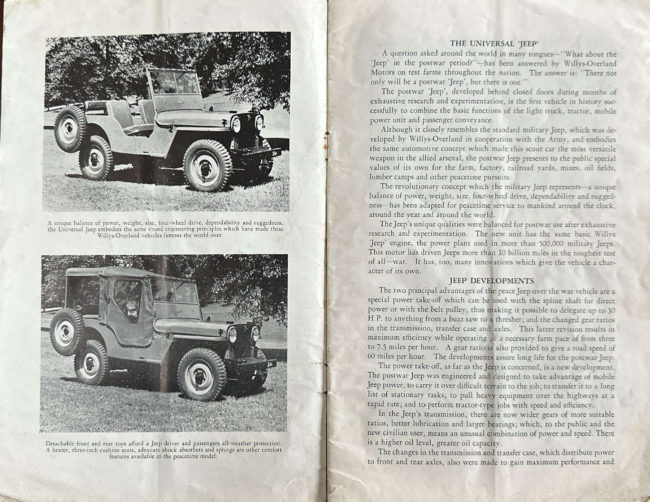

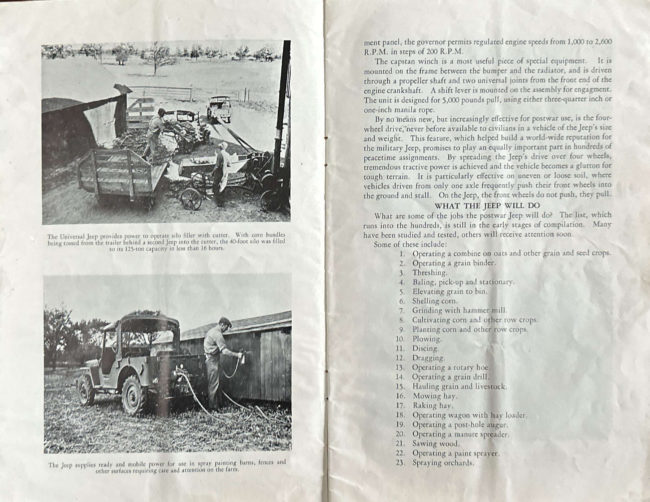
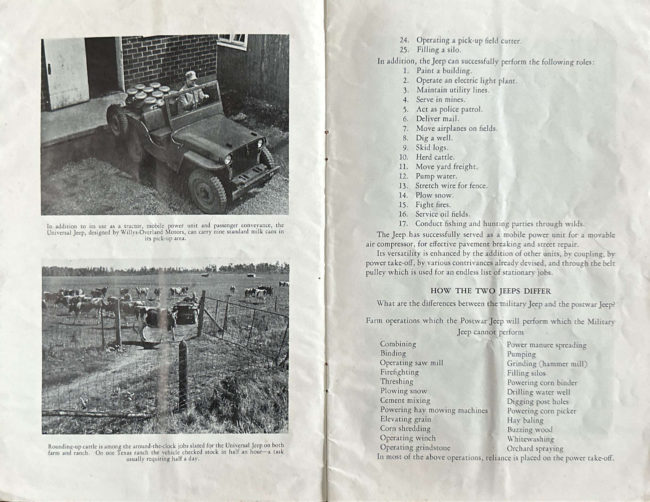
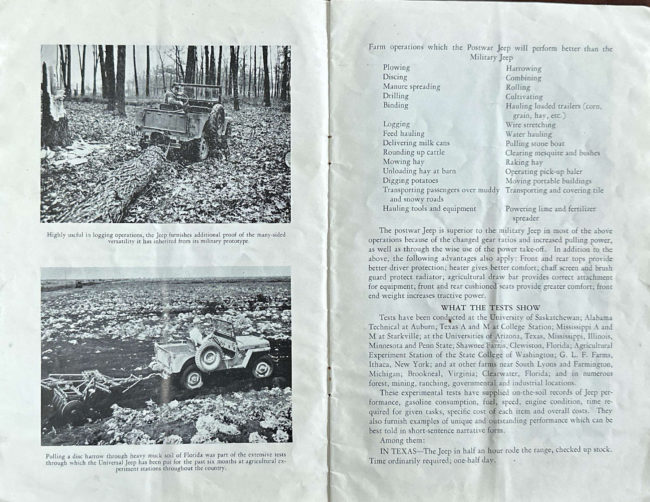
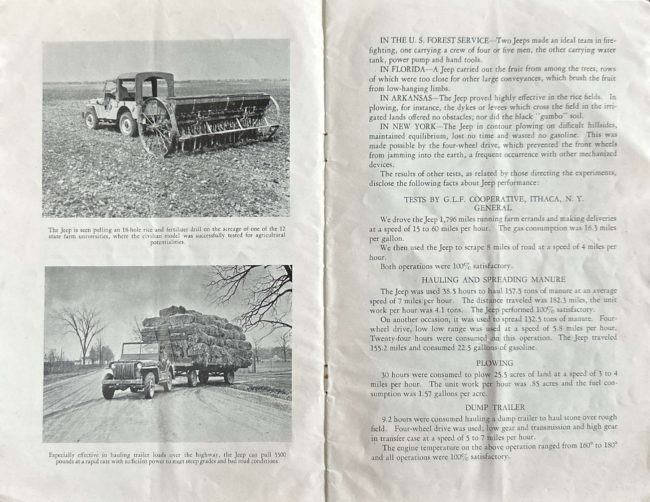
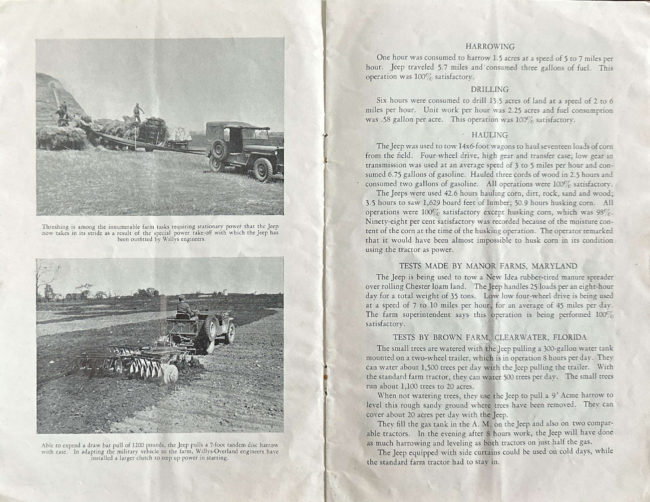
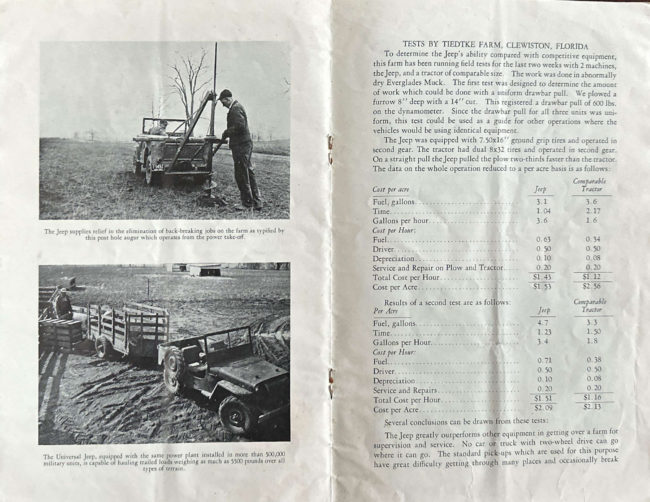
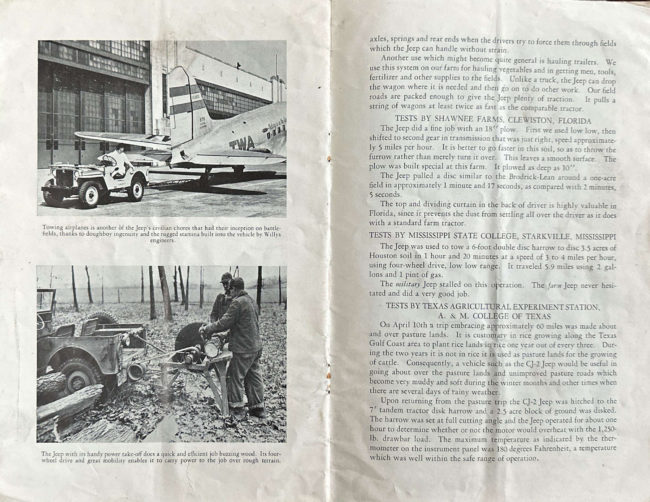
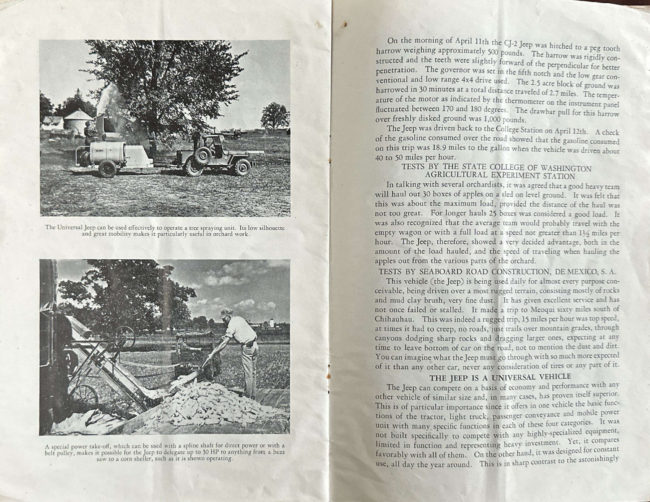
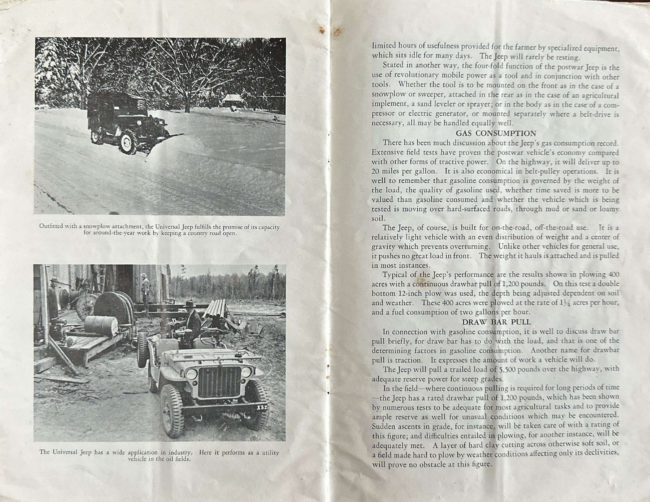
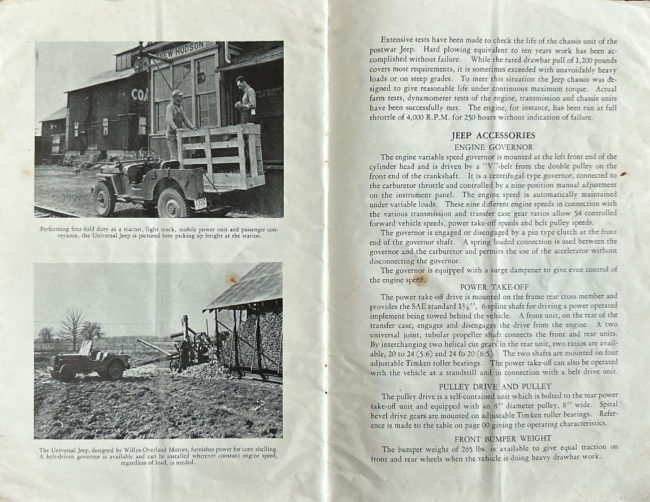
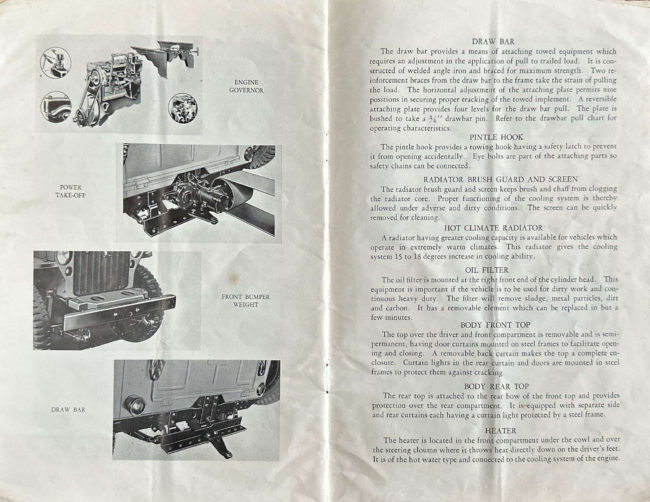
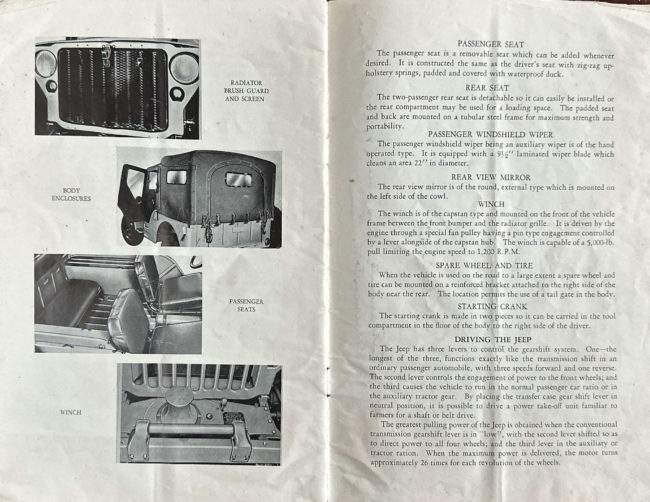
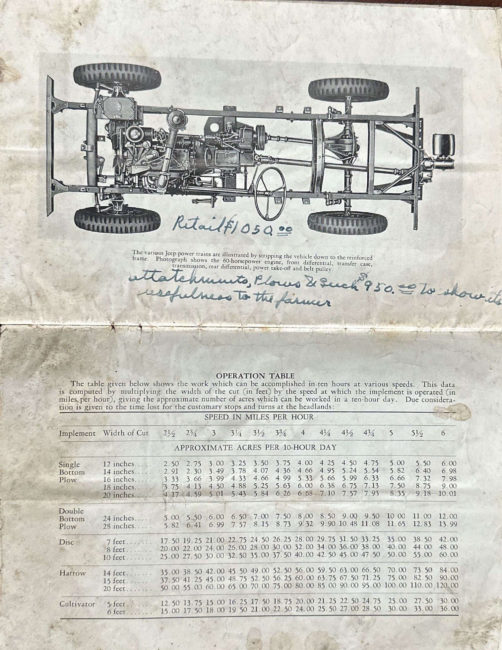
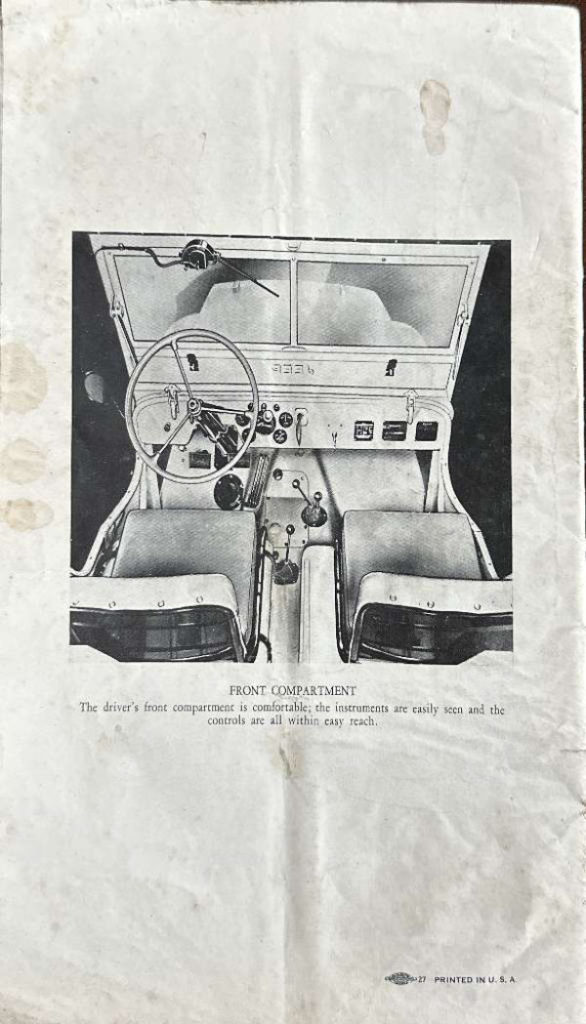
Dave,
This is a gem. With a quick read, I’ve already discovered a couple of interesting items. I’ve always wondered why the switch to the column shift – “This improvement will save wearing effort on the part of men and women of all ages who drive the peace Jeep.” Whatever that means.
I plan to spend some time reviewing the farm reports. I believe I seen a couple and this report seems to be focused on the successes. The hand written note is interesting. suggesting you (the dealer?) should obtain “attachments such as plows and such $950.00 to show its usefulness to the farmer.” That is a lot of implement dollars.
Barry T
Interesting part about Washington State College (now WSU) orchard tests.
They say two horses can tow 25 applet boxes. That doesn’t seem like a lot, but surely they don’t mean 25 of the large (5x5x5 ?) wooden crates you see in orchards here in the Northwest.
Agricultural history is an interesting topic and hugely overlooked considering its importance.
BTW…What was the price for a postwar Farm Jeep? I ‘d like to compare it with cars of the period.
So much awesome. Nice find!
John,
Maybe they were referring to boxes like these: https://www.etsy.com/listing/1396797048/old-fruit-crate-with-labelwood-fruit?
Here are some list and retail prices from around 1948: http://www.ewillys.com/2018/08/28/1948-price-list-for-various-jeeps/
– Dave
David
Yes, that’s rogue smaller boxes I was thinking of. Of course, today they are made from high strength cardboard.
We live a couple of miles from the local orchard area and see the old time labels used as decor items now.
I’ll break out my copy of The Standard Catalog of American Cars and see what the prices were for regular passenger sedans, to put the Jeep prices into perspective.
that top picture looks like the x64 photo on page 50 of Jim Allen’s jeep book. even has the same background
the 4th picture looks like the x64 on the bumper, column shifter with a ww ll grill. or is my eyes seeing things ( its getting late). sorry guys guess I ‘m a detail nut
Mark,
“Detail nuts” are always helpful. It’s not one of the my better skills. Thanks for pointing it out.
Some of these photos are part of the original July 1945 Press package. Others were likely taken as a part of assembling the press package. I’ve documents 12 of the 13 photos from the original press package here: http://www.ewillys.com/tag/1945-07-21-press-release-kit/
– Dave
David
There seems to be at least two versions of this booklet published since in the copy I have there is a detailed explanation of all the controls of the front compartment on the last page where you mention the final photo showing the early dash, which is lacking in your image.
Also, the front cover of my copy has a very similar photo to Photo #9 in the July 1945 press kit which you have linked to, although perhaps you haven´t scanned and uploaded the front cover of your copy?
Regards
Graham
Hi Graham,
That is fascinating. My guess is that mine is an earlier version? My front page is shown at top and lacks an image on it.
There is no image of the front compartment in my booklet. Other than a black back cover page, everything in my booklet is shown above.
– Dave
Dave, I’m sure you have noticed this, but In looking at the photos here and the earlier posts about the “x” marked vehicles in early press release photos, there is one other point to ID the various Jeeps used….
The half cab unit in many shots, the one towing the hay wagon, the one logging, and the snowplow are wearing tractor tread tires, not the military type.
Were they an option, or did WO officially test them or were they just an expedient given wartime shortages?
I would imagine post war, there were thousands of surplus new Jeep tires available.
John,
Some thoughts: I have noticed the tires, but I don’t know any history about what they were or why they used them. Maybe tractor tires? I don’t know when meaty irrigation tires began production, but that’s what I think of when I see these tires.
I don’t know to what degree the military was selling off surplus tires. At least with some products, civilian manufacturers, like tire manufacturers, didn’t want to compete with war surplus. Moreover, military tires didn’t have optimum grip for road or off-road purposes.
Concerning the “X”. In the military line of vehicles, the prefix “X” meant it was a prototype or pre-production test vehicle. ff: XM151 = pre-production M151 MUTT. Perhaps the CJ photographed was test unit #64. Perhaps?
Tires: I know that non-directional tires were pretty standard for CJs to the late 50s. In fact, we have NOS glove box manuals dated 1964 showing CJs sporting them. They were good for military and farm applications, but not for offroad sport or hard surfaces like paved roads. And they wear real quick! We have evidence of Goodyear whitewall Suburbanites on Tuxes as early as ’63.
JohnB
Based on the context where the oversize 7.50 digger tires are specifically mentioned, I think it was a comparison test against similar tractors and had nothing to do with availability of either type of tire.
Given WO’s wish to market the Jeep as a “Go to town when you’re done” farm vehicle, I could see where these would not be promoted as standard ware.
Barney
I understand the tire differences, I was just pointing out the differences on the test/pre-production Jeeps used in the news release photos. if nothing else, it helps give an idea about how many different vehicles were used by WO in testing.
If a Jeep was going to be used mainly off toad in muddy conditions, I could see the tires being offered as an option or installed by the dealer.
JohnB
Great point! And to that point, I also found it interesting that a test was done in the Houston area of Texas (my hometown) where it’s so tropical and muddy. Back in that day, I’m sure it was one big rice paddy. Doesn’t surprise me that my Texas A&M was involved in some of the tests.